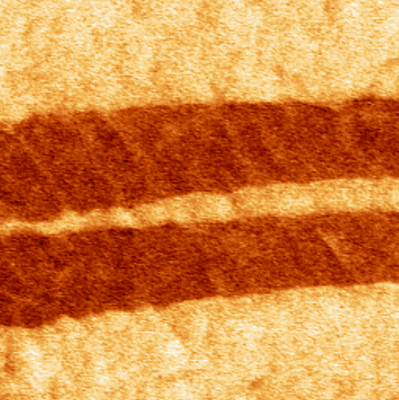A team of multi-institutional researchers led by Andrei Kholkin from the University of Aveiro has for the first time experimentally demonstrated the existence of ferroelectricity in glycine, a basic amino acid, using piezoresponse force microscopy developed at the Center for Nanophase Materials Sciences (CNMS) of the Oak Ridge National Laboratory (ORNL).
 ORNL researchers detected for the first time ferroelectric domains (seen as red stripes) in the simplest known amino acid – glycine. (Credit: ORNL)
ORNL researchers detected for the first time ferroelectric domains (seen as red stripes) in the simplest known amino acid – glycine. (Credit: ORNL)
Ferroelectricity is defined as the switch in material polarization caused by the application of an electric field. The ORNL microscopy group and Kholkin’s team studied the crystalline glycine samples grown at Kholkin's lab. Besides the experimental measurements, the researchers validated the ferroelectricity using molecular dynamics models that described the mechanisms responsible for the cause of the observed phenomenon.
Sergei Kalinin, a senior scientist at ORNL's CNMS and a member of the team that developed the microscopy, informed that the detection of ferroelectricity in biological molecules like glycine paves the way to develop new types of bioelectronic logic and memory devices in which polarization switching can be utilized to record and recover data in ferroelectric domain forms.
This study opens the door to develop memory devices using molecules in human bodies, for instance, nanorobots that are capable of circulating in human blood. However, more research is required to explore molecular-scale electromechanical coupling to build a nanomotor that can circulate in blood.
The piezoresponse force microscopy is an ideal equipment to explore the intricacies of biological systems at the nanoscale. This technique lays the foundation to perform a quantitative and reproducible analysis of this electromechanical conversion. It enables electromechanical motion study on the scale of fewer molecular assemblies or a single molecule, a level at which fascinating events can occur, Kalinin concluded.